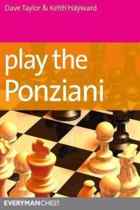Play the Ponziani
Dave Taylor, Keith Hayward

The sequence 1.e4 e5 2.Nf3 Nc6 3.c3, named after the Italian analyst and writer Domenico Lorenzo Ponziani (1719 – 1796), has never enjoyed more than surprise value in the world of grandmaster chess but perhaps that will change with the publication of Play The Ponziani by the American masters Dave Taylor and Keith Hayward. This is only the second book devoted to this opening that I am aware of. The first, Taylors Ponziani Power, was published about ten years ago.
Definitely one of the lesser-known and analyzed of the double King Pawn openings, the Ponziani is typically written off as harmless, boring or too rigid, but the authors show that it has plenty of punch and can lead to a wide variety of positions from the sharp lines commencing with 3 …d5 or 3… f5 to the more positional variations arising after 3…Nf6.
Opening this book your reviewer was curious what Taylor and Hayward would have in mind against the common-sense 3…Nf6 4.d4 Nxe4 5.d5 Ne7 6.Nxe5 Ng6 7.Qd4 (the authors main line and given an exclamation mark by them) 7…Qf6 8.Qxe4 Qxe5. Jack Peters, writing in RHMs Understanding The Open Games in 1980, said the subsequent trade of queens “produces a lifeless position and an almost certain draw. This opinion was echoed by Romanian GM Mihai Marin in his Beating the Open Games several decades later. Play the Ponziani believes there is an answer for White and that after 9.Qxe5+ Nxe5 10.Nd2 d6 11.Nc4 Nxc4 12.Bxc4 Be7 13.0-0 0-0 14.Be3 Bf6 15.a4 a6 16.a5 Bd7 17.Rfe1 Rae8 19.Kf1!? (instead of 19.f3 of Velimirovic-Smejkal, Rio de Janiero (izt) 1979) that Whites queenside space advantage is significant, providing a page full of analysis to back their assertion. Glenn Flear gives 3 Nf6/4 Nxe4 as his main line in Starting Out: Open Games so this queenless middlegame is sure to provoke further discussions.
These days, with so many books out there, it is important authors are familiar with what is being advocated against their opening. Nigel Davies in his Play 1.e4 e5! and Glenn Flear in Dangerous Weapons: 1.e4 e5, both recommend 3…Nf6 4.d4 exd4 as their double duty anti-Goring Gambit/ Ponziani line (the variation in question arises from both openings) but with different interpretations.
Davies recommends 3…Nf6 4.d4 exd4 5.e5 Nd5 as his suggested line but does not analyze the move that Play The Ponziani believes is best Minevs 6.Qb3. Flear offers the sharper 5…Ne4 when the contested position arises after 6.Qe2 f5 7.exf6 d5 8.Nbd2 Qf6 9.Nxe4 dxe4 10.Qxe4+ Qe6 11.Bd3 dxc3 12.bxc3 Qxe4 13.Bxe4 Bd7 14.Ng5 0-0-0 15.15.0-0 Re8 16.Bxh7 Bd6 17.h3 Be5!? 18.Bd2 Bf6 arises. Taylor and Haywards suggestion is 19.Bg6 with the follow-up 19…Re2 20.Nf3 Ne5 21.Nxe5 Rxe5 22.Rfc1 and “White has some prospects of utilizing the extra pawn.
Play The Ponziani isnt just limited to 1.e4 e5 2.Nf3 Nc6 3.c3 as it offers limited coverage of the Petroff (3.Nxe5 d6 4.Nf3 Nxe4 5.Nc3), Latvian (3.Nxe5 Qf6 4.Nc4 fxe4 5.Nc3 Qf7 6.Ne3) and Phildor (3.Bc4), so it provides a repertoire for those want one stop shopping for White after 1.e4 e5.
Those looking for something a little bit off the beaten track will be drawn to this book.
